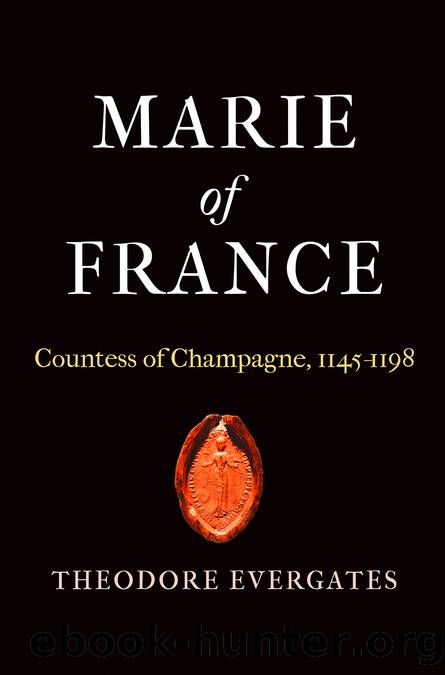Marie of France by Evergates Theodore;

Author:Evergates, Theodore;
Language: eng
Format: epub
Publisher: University of Pennsylvania Press
Published: 2019-02-14T16:00:00+00:00
Constructing Memory
The earliest pictorial image of Marie was a statuette on the tomb of her second son, Count Thibaut III, commissioned most likely within a decade of his death by his widow, Countess Blanche (1201â22).4 His metalwork tomb stood next to Henry the Liberalâs glittering gold, silver, and enamel tomb located in the nave of the comital chapel. The two effigy tombs shared similar dimensions but presented entirely different iconographical programs. Henryâs effigy lay within his tomb, visible through four arches on either side, making him in essence a relic within a reliquary that celebrated his deeds, with celestial references to the sun and Christian prophets to match his outsized persona.5 Thibautâs effigy, by contrast, rested on top of his tomb, whose four closed arches on either side contained statuettes of his closest relatives: his father and mother, his older brother Henry II and his sisters, his son and daughter, his motherâs brother (the king of Navarre), and at either end of the tomb, the kings of France and England.6 As the earliest example of a âtomb of kinship,â it located Thibaut in reference to his familial ties that justified his collateral succession as count of Champagne against the claims of his brotherâs daughters born overseas.
Standing out from the silver statuettes on Thibautâs tomb were the gilded bronze statuettes of Marie and Henry the Liberal. Henryâs statuette is inscribed: âHere is Henry, Thibaut, your father who had this church built.â7 Marieâs inscription reads: âCountess Marie; I am mother of the counts [Henry II and Thibaut III], I ask Christ to be with you.â8 A sketch of her statuette, made shortly before the tomb was destroyed, shows a stylized Marie with a hat and flowing garments, seated in an ample chair.9 If the tomb was completed before 1215, and more likely before 1209, her sculpted image might well have been made by someone who had seen her before 1198. Thibautâs tomb with its statuettes survived in St-Ãtienne for almost six hundred years, until it was dismantled and melted down in January 1794 in the aftermath of the French Revolution.10 Whether a visitor to St-Ãtienne in those intervening centuries would have known anything more about Marie beyond her inscription is doubtful.
A slightly later depiction of Marie is a color painting in a manuscript of the scribe Guiot, which contains the earliest extant collection of romances by Chrétien de Troyes (ca. 1225âca. 1250). It bears such a strong resemblance to the tomb statuette that it seems to have been modeled on it. The tomb statuette has Marie seated, with her left hand relaxed in her lap, her right hand pointing upward, and her face looking straight ahead to the viewer visiting the chapel. The painting in Guiotâs manuscript has her seated with her right hand raised and pointing to her open left hand, as if she were commanding Chrétien to write Lancelotâas he claims she didâwhile her face is turned to the right, as if she were speaking to the poet (who is absent from the scene).
Download
This site does not store any files on its server. We only index and link to content provided by other sites. Please contact the content providers to delete copyright contents if any and email us, we'll remove relevant links or contents immediately.
| Africa | Americas |
| Arctic & Antarctica | Asia |
| Australia & Oceania | Europe |
| Middle East | Russia |
| United States | World |
| Ancient Civilizations | Military |
| Historical Study & Educational Resources |
Magic and Divination in Early Islam by Emilie Savage-Smith;(1501)
Ambition and Desire: The Dangerous Life of Josephine Bonaparte by Kate Williams(1346)
Bohemians, Bootleggers, Flappers, and Swells: The Best of Early Vanity Fair by Bohemians Bootleggers Flappers & Swells- The Best of Early Vanity Fair (epub)(1344)
Papillon by Henry Charrière(1311)
Twelve Caesars by Mary Beard(1258)
Operation Vengeance: The Astonishing Aerial Ambush That Changed World War II by Dan Hampton(1138)
What Really Happened: The Death of Hitler by Robert J. Hutchinson(1131)
London in the Twentieth Century by Jerry White(1114)
Time of the Magicians by Wolfram Eilenberger(1089)
The Japanese by Christopher Harding(1086)
Twilight of the Gods by Ian W. Toll(1084)
Lenin: A Biography by Robert Service(1045)
The Devil You Know by Charles M. Blow(985)
A Social History of the Media by Peter Burke & Peter Burke(939)
Freemasons for Dummies by Hodapp Christopher;(923)
Napolean Hill Collection by Napoleon Hill(905)
Henry III by David Carpenter;(892)
The Churchill Complex by Ian Buruma(884)
The Rise and Triumph of the Modern Self by Unknown(880)
